Dr. David Baker, Physics Department, Austin College

Undergraduate Research Projects
Senior Honors Thesis
Imaging of Extragalactic Supernovae, John Donor and Aryn Hays, January 2014.
Web Development using Joomla for an Extreme Book, Thomas Joiner, Austin College, Summer 2009.
Observed Dust Devil Tracks in the North Polar Region of Mars, Nathan Drake, NASA Jet Propulsion Laboratory, Summer 2005. See further details in the honors thesis section above.
Surface Energy Balance of a Prairie Environment in North Texas, Tru Robertson, Austin College, Summer 2004.
Calibration of a Laser for Atmospheric Measurements, Christen Currie, NASA Goddard Space Flight Center, Summer 2003.
Summer and January Research
Numerical Simulations of Urban Heat Island Precipitation Effects, Mark Hagge, 2013. Mark explored the effects of the Dallas-Ft. Worth urban area on precipitation. He determined that more rainfall occurs downwind of the urban area.
Observed Dust Devil Tracks in the North Polar Region of Mars, Nathan Drake, 2006. Nathan conducted much of this research at NASA’s Jet Propulsion Laboratory in Summer 2005. Nathan also was first author in a top-tiered scientific journal (Geophysical Research Letters) on this research. He presented this research at a NASA-sponsored workshop “Dust Devils on Earth and Mars” in Tempe, Arizona (2005), and his research was presented at the American Geophysical Union Fall Meeting in 2005.
The Effect of Lake Texoma on Precipitation, Binaya Poudyal, 2005.
Comparison of Satellite Precipitation Estimates and Rain Gauge Measurements in North Texas, Chris Perez, 2002. Chris conducted some of this research at NASA Goddard Space Flight Center in January 2002.
Research Experiences in Physics (Regular Semester)
Students in the Atmospheric and Environmental Physics course become experts on at least one instrument of the Austin College Weather Station. After testing, calibrating, and installing their sensors, they conduct original research using their instruments’ measurements. Students present their results in a campus-wide poster session.

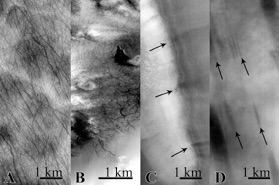
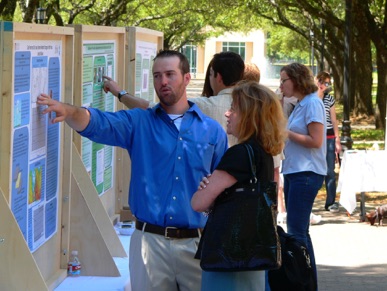
Semester-Long Research Projects associated with Regular Courses
Detecting Giant Storms on Jupiter, Amy Glazier, Josi Ridenour, James Tenney, & Evan Wyatt, Spring 2015.
Bow Shock Physics in the Orion Nebula, John Chesser, Anthony Johnsen, Connor Rigg and Chris Tanner, Spring 2015.
Custom Calibration for Soil Moisture at the Austin College Weather Station, Amy Anderson, Lindsay Bechtel, and Albert Chung, Spring 2013.
The Power Problem at the Austin College Weather Station and How We Fixed It, Anthony Johnsen and Chris Tanner, Spring 2013.
Search for Exoplanets Using Kepler Space Telescope Data, James Duncan and Landon Hendrix, Spring 2012.
Optics Specifications and Instrumentation for the IDEA Center Astronomical Observatory, Graham Crannell and Aryn Hays, Spring 2012.
Soil Moisture and Soil Temperature at the Austin College Weather Station: A Customized Calibration, Landon Hendrix, Michael Holcomb, Matthew Wescott, Spring 2011.
New Data Collection and Updated Web Site for the Austin College Weather Station, Mark Hagge and Will Navey, Spring 2011.
Astroimaging of the Moon and Planets, Lauren Dorsett, Daniel Hook, Matt Varvir, Genevieve Walker, Spring 2010.
CCD Imaging of Jupiter, Andrew Maxwell, Sean Muder, Patrick Reese, Fall 2009.
Solar Eclipses in Our Solar System, David Riddle, Jordan Robison, Spring 2009.
Energy Efficiency of Residential Windows, Paul Cremer, Will Rusinko, Matt Varvir, Fall 2008.
Dust Storms and Density Flows on Mars, Mason Anders, Jalina Keeling, Spring 2008.
Energy Efficiency of Residential Windows, George Jacob, Jason Jorgenson, Fall 2007.
Reduction of Dew Point Temperature Errors with the Dew-10 Chilled Mirror Hygrometer, Tyler Moore, Cole Musselman, Fall 2006.
Librations of the Moon: Experimental and Theoretical Studies, Fred Holt, Nic Rady, Tommy Shelton, Spring 2006.
Imaging Mars at Austin College, Matt Fletcher, Heather Quantz, Cicily Smith, Fall 2005.
CCD Imaging of Saturn and Jupiter, Kyle Borg, Nathan Drake, Leah Petersen, Spring 2005.
Nonlinear Dynamics of the Carbon Cycle, Kyle Borg, Fall 2004.
Measuring Sunlight at the Austin College Weather Station, Fred Holt, Catie Talbert, Fall 2004.

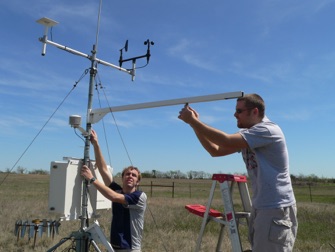
Installation of new sensors at the Austin College Weather Station. Students conducted semester-long authentic research projects as part of the Atmospheric and Environmental Physics course.




Nathan Drake’s honor thesis uncovered evidence of dust devils near the north pole of Mars. This research helped determine the landing site of NASA’s Mars Phoenix Lander on the red planet. The image shows
-
A)linear dust devil tracks
-
B)curvy dust devil tracks
-
C)wind streaks
-
D)cloud shadows
Image Credit: Drake et al. (2006).
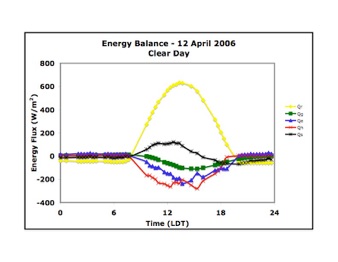
Summer research by undergraduate Tru Robertson provided the foundation for future energy balance studies. Here, the energy balance at the Austin College Weather Station is calculated over a 24-hour period. Energy is partitioned into net radiation (Qr), ground heat flux (Qg), latent heat (Qe), sensible heat (Qh), and heat storage in the soil (Qs). These data provide insight on the local climate.
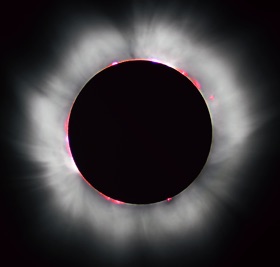
Every semester, physics majors conduct research with Austin College faculty. Students write proposals, investigate real scientific problems, write research papers, and present their results in the Physics Department Colloquium.
As part of their Research Experience in Physics course, undergraduates David Riddle and Jordan Robison discovered, through their own calculations, that Earth is the only planet in our Solar System to witness perfect solar eclipses.
Image Credit: Luc Viatour

Research at the Adams Observatory
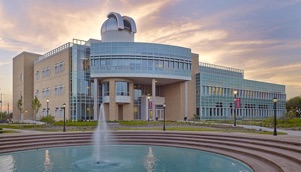
Student research at the Adams Observatory is ongoing. Please visit the Adams Observatory Student Research page for a listing of research projects using this state-of-the-art facility. My research students have explored giant storms on Jupiter, bow shocks in the Orion Nebula, and imaging techniques for planetary and deep space objects.
